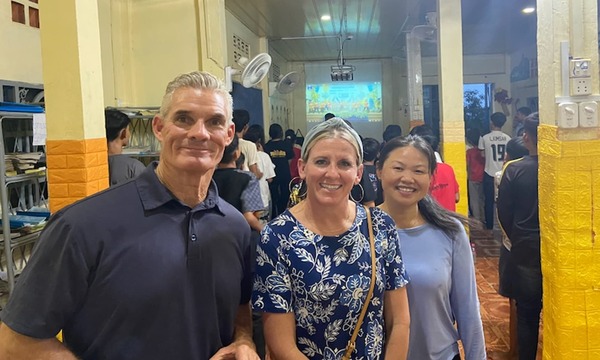“Ain’t nobody here to love me.” The words of Chera Williams echoed in Biola junior Katie Watson’s mind and heart. Tears welled in her eyes as she listened to Williams, who spends her days and nights on Skid Row, explain how her husband and eight children were all gone. The hopelessness of Williams’ words sunk into Watson’s spirit — how could she tell her there was hope when she has a family and warm bed to go home to?
“I had everything she didn’t,” said Watson. “Walking away, I realized how desperately so many need Jesus — how desperately we all do. I will never forget her face.”
Fifteen Biola journalism students set out in January prepared to write and photograph the stories of individuals who live in the nation’s largest concentrated area of homelessness — Skid Row. The end result of their three-week narrative journalism class would be a published book, titled “Skid Row: You Don’t Come Down Here Without Change!”
“Suffice it to say that before the class began, I had no idea what I had signed myself up for,” said junior Tiffany Sun, one of the writers.
As students walked the streets of South San Pedro, went on police ride-alongs, and shadowed workers and residents at the Union Rescue Mission (founded by Lyman Stewart, one of Biola’s founders), the rising journalists and photographers encountered more than homelessness; they encountered their hearts.
“The book project basically closed the gap, between the homeless and me, that I had been creating all my life,” said junior Tomoko Taguchi, a photographer. “I grew up in a third-world country, but somehow managed to avoid the issue in my heart. This book project and the experience that came with it brought me face to face with homelessness and homeless people.”
For three weeks, the sleep-deprived students wrote, photographed and documented the stories of skid row “residents.” Discovering the brokenness of those with mental health issues and drug and alcohol addictions, and those who simply no longer have a home or family, the reality of homelessness cut the lines between student and subject.
“It was strange to be carrying around an expensive SLR camera, while seeing that all some of them needed was a blanket,” said Taguchi. “It is a somewhat ambiguous line that cuts between my roles – photojournalist versus human.”
Junior Karissa Tse realized the prejudices and feelings of superiority she had from being born into a financially stable family.
“Creating relationships changes all of that,” she said. “I was able to see their struggles, triumphs and source of strength just by listening to their stories.”
More than listening, Tse began to learn how to be a photojournalist — the reason she originally enrolled in the class.
“When I would overhear a joke being delivered or a laugh about to erupt, I would get my camera ready to hit the shutter,” said Tse. “I learned that a big part about an excellent photograph is the moment and the ability to capture the essence or feel of what was happening in someone’s life.”
Feeling the pressure of writing a book in three weeks, the four writers Watson, Sun, senior Brittany McComb and senior Bethany Miller, were overwhelmed at the start. Sun recalls journalism professor Mark Landsbaum asking them to write a lede for one of their assigned chapters and then tearing it to shreds for the next hour.
“I learned to write concisely, and to guard against writing to please myself,” said Sun. “I learned to try and focus on the straight talk, instead of on trying to be creative.”
The narrative book class is the result of journalism department chairman, Michael Longinow’s desire for students to have the opportunity to partake in a long-form journalism project.
"Nothing is as powerful a learning tool for student writers or student photojournalists as the street," said Longinow. "When they're on the cracked sidewalks, stepping over broken glass, looking into the leathery faces of women and men who survive one day at a time, the hard work of storytelling and pursuit of meaning and truth are no longer theory. This project did more than make Biola students better journalists. It made them stronger believers in the God who brings light and hope where there seems to be only darkness and despair."
The first year in 2009, students spent time with KidWorks in Santa Ana. This year, they traveled to Biola’s roots in Los Angeles.
“In this book are the insights of university students who made it their purpose to bridge a chasm of culture and economics between a classroom in La Mirada — a city far removed from Skid Row — and one of Los Angeles’ most vexing civic puzzles,” wrote Longinow in the foreword of the 161-page book incorporating student’s writing and photographs.
“I will remember the faces of the lost, of the broken. I will remember the faces of my teammates as we drove away from the streets, truly forever changed,” said Watson. “But more than anything, I will remember the faithfulness of God as we returned from the city with stories that would change our hearts and minds — and Lord willing, the hearts and minds of others.”
In spring 2011, the narrative book class will be covering Haiti over the course of the entire spring semester.
Written by Jenna Bartlo, Media Relations Coordinator. Jenna can be reached at (562) 777-4061 or through email at jenna.l.bartlo@biola.edu.
 Biola University
Biola University
_(1).jpeg)
.jpg)